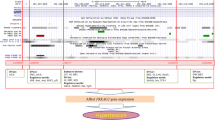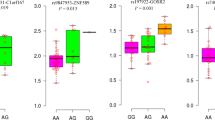Abstract
Most non-significant individual single nucleotide polymorphisms (SNPs) were undiscovered in hypertension association studies. Their possible SNP–SNP interactions were usually ignored and leaded to missing heritability. In present study, we proposed a particle swarm optimization (PSO) algorithm to analyze the SNP–SNP interaction associated with hypertension. Genotype dataset of eight SNPs of renin-angiotensin system genes for 130 non-hypertension and 313 hypertension subjects were included. Without SNP–SNP interaction, most individual SNPs were non-significant difference between the hypertension and non-hypertension groups. For SNP–SNP interaction, PSO can select the SNP combinations involving different SNP numbers, namely the best SNP barcodes, to show the maximum frequency difference between non-hypertension and hypertension groups. After computation, the best PSO-generated SNP barcodes were dominant in non-hypertension in terms of the occurrences of frequency differences between non-hypertension and hypertension groups. The OR values of the best SNP barcodes involving 2–8 SNPs were 0.705–0.334, suggesting that these SNP barcodes were protective against hypertension. In conclusion, this study demonstrated that non-significant SNPs may generate the joint effect in association study. Our proposed PSO algorithm is effective to identify the best protective SNP barcodes against hypertension.

Similar content being viewed by others
References
Mehri S, Mahjoub S, Hammami S et al (2012) Renin-angiotensin system polymorphisms in relation to hypertension status and obesity in a Tunisian population. Mol Biol Rep 39:4059–4065
Turgut S, Akin F, Akcilar R et al (2011) Angiotensin converting enzyme I/D, angiotensinogen M235T and AT1-R A/C1166 gene polymorphisms in patients with acromegaly. Mol Biol Rep 38:569–576
Wu SJ, Chiang FT, Jiang JR et al (2003) The G-217A variant of the angiotensinogen gene affects basal transcription and is associated with hypertension in a Taiwanese population. J Hypertens 21:2061–2067
Wu SJ, Chiang FT, Chen WJ et al (2004) Three single-nucleotide polymorphisms of the angiotensinogen gene and susceptibility to hypertension: single locus genotype vs. haplotype analysis. Physiol Genomics 17:79–86
Tsai CT, Hwang JJ, Lai LP et al (2009) Interaction of gender, hypertension, and the angiotensinogen gene haplotypes on the risk of coronary artery disease in a large angiographic cohort. Atherosclerosis 203:249–256
Tsai CT, Fallin D, Chiang FT et al (2003) Angiotensinogen gene haplotype and hypertension: interaction with ACE gene I allele. Hypertension 41:9–15
Jiang Z, Zhao W, Yu F et al (2001) Association of angiotensin II type 1 receptor gene polymorphism with essential hypertension. Chin Med J (Engl) 114:1249–1251
Srivastava K, Sundriyal R, Meena PC et al (2012) Association of angiotensin converting enzyme (insertion/deletion) gene polymorphism with essential hypertension in northern Indian subjects. Genet Test Mol Biomarkers 16:174–177
Niu W, Qi Y (2010) Association of the angiotensin II type I receptor gene +1166 A>C polymorphism with hypertension risk: evidence from a meta-analysis of 16,474 subjects. Hypertens Res 33:1137–1143
Manolio TA, Collins FS, Cox NJ et al (2009) Finding the missing heritability of complex diseases. Nature 461:747–753
Stringer S, Wray NR, Kahn RS et al (2011) Underestimated effect sizes in GWAS: fundamental limitations of single SNP analysis for dichotomous phenotypes. PLoS ONE 6:e27964
Yen CY, Liu SY, Chen CH et al (2008) Combinational polymorphisms of four DNA repair genes XRCC1, XRCC2, XRCC3, and XRCC4 and their association with oral cancer in Taiwan. J Oral Pathol Med 37:271–277
Lin GT, Tseng HF, Chang CK et al (2008) SNP combinations in chromosome-wide genes are associated with bone mineral density in Taiwanese women. Chin J Physiol 51:32–41
Lavender NA, Rogers EN, Yeyeodu S et al (2012) Interaction among apoptosis-associated sequence variants and joint effects on aggressive prostate cancer. BMC Med Genomics 5:11
Yang CW, Li CI, Liu CS et al (2013) The joint effect of cigarette smoking and polymorphisms on LRP5, LEPR, near MC4R and SH2B1 genes on metabolic syndrome susceptibility in Taiwan. Mol Biol Rep 40:525–533
Tsai CT, Hwang JJ, Ritchie MD et al (2007) Renin-angiotensin system gene polymorphisms and coronary artery disease in a large angiographic cohort: detection of high order gene–gene interaction. Atherosclerosis 195:172–180
Heslop CL, Tebbutt SJ, Podder M et al (2012) Combined polymorphisms in oxidative stress genes predict coronary artery disease and oxidative stress in coronary angiography patients. Ann Hum Genet 76:435–447
Montasser ME, Gu D, Chen J et al (2011) Interactions of genetic variants with physical activity are associated with blood pressure in Chinese: the GenSalt study. Am J Hypertens 24:1035–1040
Meyers KJ, Chu J, Mosley TH et al (2010) SNP–SNP interactions dominate the genetic architecture of candidate genes associated with left ventricular mass in African–Americans of the GENOA study. BMC Med Genet 11:160
Kaur R, Das R, Ahluwalia J et al (2012) Synergistic effect of angiotensin II type-1 receptor 1166A/C with angiotensin-converting enzyme polymorphism on risk of acute myocardial infarction in north Indians. J Renin Angiotensin Aldosterone Syst 13:440–445
Chang HW, Chuang LY, Ho CH et al (2008) Odds ratio-based genetic algorithms for generating SNP barcodes of genotypes to predict disease susceptibility. OMICS 12:71–81
Emily M, Mailund T, Hein J et al (2009) Using biological networks to search for interacting loci in genome-wide association studies. Eur J Hum Genet 17:1231–1240
Yang CH, Chuang LY, Cheng YH et al (2012) Single nucleotide polymorphism barcoding to evaluate oral cancer risk using odds ratio-based genetic algorithms. Kaohsiung J Med Sci 28:362–368
Guy RT, Santago P, Langefeld CD (2012) Bootstrap aggregating of alternating decision trees to detect sets of SNPs that associate with disease. Genet Epidemiol 36:99–106
Lin GT, Tseng HF, Yang CH et al (2009) Combinational polymorphisms of seven CXCL12-related genes are protective against breast cancer in Taiwan. OMICS 13:165–172
Mitra AK, Singh SV, Garg VK et al (2011) Protective association exhibited by the single nucleotide polymorphism (SNP) rs1052133 in the gene human 8-oxoguanine DNA glycosylase (hOGG1) with the risk of squamous cell carcinomas of the head and neck (SCCHN) among north Indians. Indian J Med Res 133:605–612
Yang CH, Chuang LY, Chen YJ et al (2011) Computational analysis of simulated SNP interactions between 26 growth factor-related genes in a breast cancer association study. OMICS 15:399–407
Rodrigues P, Furriol J, Tormo E et al (2012) The single-nucleotide polymorphisms +936 C/T VEGF and −710 C/T VEGFR1 are associated with breast cancer protection in a Spanish population. Breast Cancer Res Treat 133:769–778
Chuang LY, Lin YD, Chang HW et al (2012) An improved PSO algorithm for generating protective SNP barcodes in breast cancer. PLoS ONE 7:e37018
Kennedy J, Eberhart RC (1995) Particle swarm optimization. Proceedings IEEE international conference on neural networks, Perth, Australia, pp 1942–1948
Niknam T, Amiri B (2010) An efficient hybrid approach based on PSO, ACO and k-means for cluster analysis. Appl Soft Comput 10:183–197
Chen LF, Su CT, Chen KH (2012) An improved particle swarm optimization for feature selection. Intell Data Anal 16:167–182
Bratton D, Kennedy J (2007) Defining a standard for particle swarm. Swarm Intelligence Symposium, 2007. SIS 2007. IEEE, pp 120–127
Chiang FT, Hsu KL, Chen WM et al (1998) Determination of angiotensin-converting enzyme gene polymorphisms: stepdown PCR increases detection of heterozygotes. Clin Chem 44:1353–1356
Hilgers KF, Langenfeld MR, Schlaich M et al (1999) 1166 A/C polymorphism of the angiotensin II type 1 receptor gene and the response to short-term infusion of angiotensin II. Circulation 100:1394–1399
Zhang F, Yang Y, Hu D et al (2012) Lack of an association between TSC gene Arg904Gln polymorphisms and essential hypertension risk based on a meta-analysis. Genet Mol Res 11:3511–3517
Polimanti R, Piacentini S, Lazzarin N et al (2012) Lack of association between essential hypertension and GSTO1 uncommon genetic variants in Italian patients. Genet Test Mol Biomarkers 16:615–620
Li YY (2012) Lack of association of A-6G polymorphism of AGT gene with essential hypertension in the Chinese population. J Cardiovasc Med (Hagerstown) 13:505–510
Ayadi Kabadou I, Soualmiaa H, Jemaa R et al (2012) Lack of association between C3123A polymorphism of the angiotensin II type 2 receptor gene and hypertension in Tunisian population. Tunis Med 90:619–624
Chang HW, Yang CH, Ho CH et al (2009) Generating SNP barcode to evaluate SNP–SNP interaction of disease by particle swarm optimization. Comput Biol Chem 33:114–119
Chuang LY, Chang HW, Lin MC et al (2012) Chaotic particle swarm optimization for detecting SNP–SNP interactions for CXCL12-related genes in breast cancer prevention. Eur J Cancer Prev 21:336–342
Su G, Christensen OF, Ostersen T et al (2012) Estimating additive and non-additive genetic variances and predicting genetic merits using genome-wide dense single nucleotide polymorphism markers. PLoS ONE 7:e45293
Sober S, Org E, Kepp K et al (2009) Targeting 160 candidate genes for blood pressure regulation with a genome-wide genotyping array. PLoS ONE 4:e6034
Acknowledgments
This work was supported by the National Science Council of Taiwan NSC 94-2320-B-037-014 to Shyh-Jong Wu, NSC101-2221-E-214-075 to Li-Yeh Chuang, NSC101-2622-E-151-027-CC3 to Cheng-Hong Yang, and NSC101-2320-B-037-049 to Hsueh-Wei Chang, the Department of Health, Executive Yuan, Republic of China (DOH102-TD-C-111-002), the Kaohsiung Medical University Research Foundation (KMUER001), and the National Sun Yat-Sen University-KMU Joint Research Project (#NSYSUKMU 102-034).
Conflict of interest
The authors declared no conflicts of interest.
Author information
Authors and Affiliations
Corresponding authors
Rights and permissions
About this article
Cite this article
Wu, SJ., Chuang, LY., Lin, YD. et al. Particle swarm optimization algorithm for analyzing SNP–SNP interaction of renin-angiotensin system genes against hypertension. Mol Biol Rep 40, 4227–4233 (2013). https://doi.org/10.1007/s11033-013-2504-8
Received:
Accepted:
Published:
Issue Date:
DOI: https://doi.org/10.1007/s11033-013-2504-8




